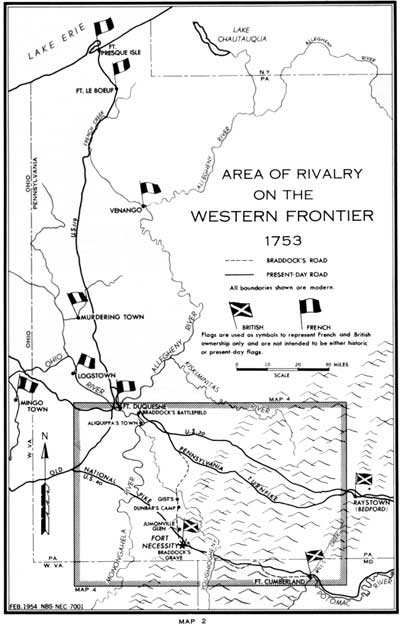|
FORT NECESSITY National Battlefield |
 |

(click on image for an enlargement in a new window)
The Fort Necessity Campaign (continued)
THE EXPEDITION AGAINST FORT DUQUESNE. Governor Dinwiddie decided upon a policy of action. In January 1754, under his order, a company of volunteer militia was raised in Virginia to forestall French encroachment. Capt. William Trent was in charge of the small force and, arriving at the forks of the Ohio in February, began to build a log fort. Trent returned to Wills Creek, leaving Ensign Edward Ward and about 40 men to continue building the fort. Before it was half completed, work was ended abruptly. On April 17, some 500 Frenchmen under the command of Capt. Pierre de Contrecoeur appeared suddenly, with artillery, coming down the Allegheny in a swarm of boats. They compelled Ward to surrender the fort and permitted him to withdraw to the colonies. The French then razed the English fort and proceeded at once to erect a strong fortification which they named Fort Duquesne for the Governor General of Canada. Contrecoeur became commander of the line of forts extending from the Ohio to Presque Isle.
The Virginia Assembly, meanwhile, deemed the situation serious enough to vote money and to raise a force of militia for the campaign. A small regiment of 300 Virginia frontiersmen under Col. Joshua Fry, with George Washington, now a lieutenant colonel, second in command, soon was ready to march to the Ohio to reinforce Ward's party building the fort and to garrison it against anticipated French attack.
The expelled garrison from the fort on the Ohio River, returning homeward, met the reinforcements under Fry and Washington at Wills Creek. Reports from the Ohio brought the alarming news that the French were receiving reinforcements and that the British traders who had ventured into that area were being driven out of the country. The Virginians now took the attitude that the French had committed an act of war. Washington was ordered to proceed to the mouth of Redstone Creek on the Monongahela River, where the Ohio Company had erected a storehouse the preceding year. This point (now the location of Brownsville) was to be the base of operations for the attack on Fort Duquesne. While Fry marched toward Wills Creek, Washington pushed on with a few companies over the Nemacolin Path.
With great difficulty, Washington's force of 60 men succeeded in cutting a road across the mountains. By May 7, the party had reached Little Meadows, having traveled a distance of about 20 miles at an average of 3 miles a day. At the Great Crossing of the Youghiogheny, realizing that the remaining 40 miles would be exceedingly difficult to traverse, Washington sent a detachment down the river by boat to locate a new route. Finding impassable rapids in the river below Turkey Foot (now Confluence), Washington returned to Great Crossing and continued overland westward. On May 24, with the first wheeled vehicle and artillery to cross the Alleghenies, he arrived at Great Meadows, an open swampy vale 50 miles from Wills Creek and 5 miles east of Chestnut Ridge.
The open glade in the forest, with its running brook assuring a water supply, seemed an ideal campsite and a place from which to reconnoiter the country. Learning from the Half King that a strong detachment of French and Indians was on the march from Fort Duquesne, Washington took immediate steps to fortify the position and "placed troops behind two natural Entrenchments and had our wagons put there also." As the work of fortifying the place progressed, Washington reported to Governor Dinwiddie "We have, with Nature's assistance, made a good Intrenchment, and by clearing ye Bushes out of these Meadows, prepar'd a charming field for an Encounter." The natural entrenchments to which Washington referred were apparently the banks of Great Meadows Run and Indian Run where they form a juncture. Although the valley was nearly all marshland, Washington believed it had military advantages.

|

| History | Links to the Past | National Park Service | Search | Contact |
|
Last Modified: Mon, Dec 2 2002 10:00:00 am PDT |

